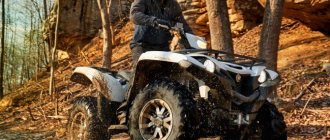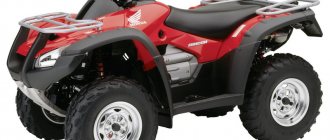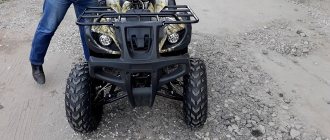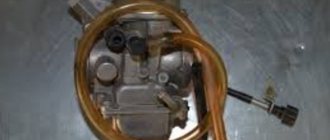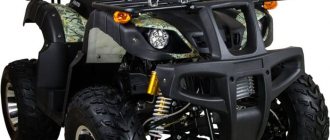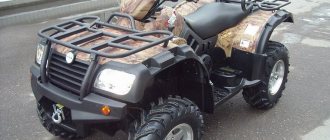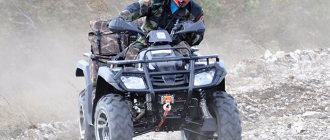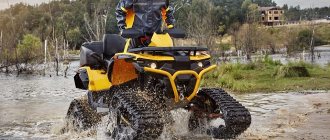At first glance, the Yamaha Grizzly 350 ATV model differs from most of its analogues in not having the best impression. This is explained by the fact that the all-terrain vehicle does not have the frills that are found in modern models. Namely, it does not have a front center differential lock and a reduction gear in the transmission system, and it is also equipped with:
- Engine with carburetor fuel system.
- Dependent rear suspension.
- Air cooling system.
The braking system features hydraulically driven disc brakes at the front and a sealed mechanically driven drum brake at the rear.
Initially, the ATV is not equipped with power steering, however, even without it, steering is quite easy. Despite the outdated design of the rear brake mechanism, braking is quite effective, moreover, the brakes respond instantly to the slightest pressure. The suspension of the model provides the all-terrain vehicle with a smooth ride and increased stability. Compared to its counterparts that have larger power plants, which are most often equipped with a liquid-type cooling system, this model is able to work properly and without overheating even at temperatures of plus 30 degrees. This feature is due to a thoughtful design. It has an impressive radiator with a fan that immediately turns on when it receives a signal from the engine temperature sensor. The air filter is distinguished by a modified housing, which has an inclined design consisting of several niches. In addition, this element additionally has a removable plug, which helps prevent water from entering when driving in difficult conditions, thereby protecting the power plant from water hammer. Cooling air comes from a cavity located near the fuel tank at the very top of the ATV. This cavity is reliably protected from dirt. The manufacturer placed the transmission system breathers on the air intake hose.
Video
The Yamaha Grizzly 350 has the simplest possible all-wheel drive system. The front gearbox is connected via a separate electric motor, which in turn operates when switching the 2WD or 4WD modes on the steering wheel. The transmission system includes forward gear (F), reverse gear (R), as well as neutral gear (N). The absence of a downshift in this case is fully compensated by the high engine power. Often in reviews, owners state that off-road equipment does not need additional gears at all. Therefore, for any type of riding, the ATV only needs the F mode range.
The equipment is suitable for both active recreation and household tasks. It should be noted that the greatest popularity came precisely because of its operational capabilities, which in turn are due to:
- Compact overall dimensions, making the ATV easy to maneuver in tight spaces.
- A textured tread pattern that provides increased traction on almost any surface.
- The presence of two spacious luggage platforms, which together provide the ability to transport cargo weighing up to 120 kilograms.
- Sufficient traction force to allow you to tow any heavy loads.
Market leaders
The number of manufacturers of this type of vehicle is growing in step with their popularity among consumers. Their leaders include such well-known brands as: Polaris, Suzuki, Kawasaki, Honda. This list would be incomplete without one of the world leaders - Yamaha, one of the largest manufacturers of motorcycles, ATVs, snowmobiles and much other equipment. The Grizzly ATV of this brand is one of the most popular models in the world. Grizzly from Yamaha quickly gained popularity due to its power and technology, as well as originality, both external and internal.
Specifications
Power point:
- The type of engine installed is gasoline, four-stroke.
- Number of cylinders – 1.
- Working volume – 348 cubic meters.
- The cylinder diameter is 83 millimeters.
- The piston stroke is 64.5 millimeters.
- The compression ratio in the combustion chamber is 9.2:1.
- Rated output power is 21 horsepower/15.5 kilowatts (at 6000 rpm).
- The nominal crankshaft rotation speed is 6000 rpm.
- Number of camshafts – 1.
- The camshaft location is overhead (SOHC).
- Number of valves per cylinder – 2.
- Type of cooling system – air.
- Type of lubrication system – oil bath.
- Type of fuel system – carburetor.
- The type of carburetor used is Mikuni BSR33.
- Air filter type – paper element.
- Recommended fuel is not lower than AI-92.
- Recommended oil is 10w40.
- Ignition system type – electronic DC-CDI.
- Type of starting system – electric starter or inertial.
Chassis:
- Drive type – cardan.
- Transmission system type – Automatic Yamaha Ultramatic ®.
- Clutch type – disc, dry.
- Number of gears – F/N/R.
- Frame type – tubular, spatial, made of high-strength steel.
- The front suspension type is independent, with double wishbones and five-position adjustment.
- Rear suspension type: dependent, pendulum with five-position adjustment.
- Front suspension travel is 160 millimeters.
- Rear suspension travel is 180 millimeters.
- The type of front shock absorbers is hydraulic.
- The type of rear shock absorbers is hydraulic.
- Front tires – off-road, AT25x8.00-12.
- Rear tires – off-road, AT25x10.00-12.
- The type of front discs is stamped, made of steel.
- The type of rear discs is stamped, made of steel.
- Front brake type: disc with hydraulic drive.
- Rear brake type: sealed drum with mechanical drive.
- Steering type - Ackermann.
Dimensions:
- Structural length – 1984 millimeters.
- Structural width – 1085 millimeters.
- Structural height – 1120 millimeters.
- The wheelbase length is 1233 millimeters.
- The lowest ground clearance is 180 millimeters.
- The smallest turning radius is 3200 millimeters.
Other characteristics:
- The capacity of the fuel tank is 13.5 liters.
- The structural weight of the ATV is 245 kilograms.
- Maximum speed is 80 kilometers per hour.
- The maximum load capacity on the front luggage platform is 40 kilograms.
- The maximum load capacity on the rear luggage platform is 80 kilograms.
- The maximum pulling force on the hook is 500 kilograms.
- Number of places – 2.
Test drive Yamaha Grizzly 350 Automatic
Often, manufacturers and importers of various motorcycles try to embellish the merits of their engineering creations and cover up some of the shortcomings. To create names, advertising slogans, logos and other advertising paraphernalia, they use the work of many PR specialists, in order to then present the people with a “tasty shell”, from which, according to their plan, potential buyers should begin to salivate and have a desire to buy IT. Later it may set your teeth on edge, but... the job has already been done. And potential buyers develop a reflex of distrust of advertising...
On one sunny summer day, Yamaha provided the opportunity to test the Yamaha Grizzly 350 4WD Ultramatic in Kyiv. The testing site was an ATV track not far from the cross-country motorcycle track in Pirogovo.
Having read the press release in advance, I remember well that the engine has 348 “cubes” fed by a carburetor, a CVT and switchable all-wheel drive. What else do you need to remember if in a couple of minutes you have the opportunity to try everything? True, what was most memorable from the press release was the slogan that Yamaha “awarded” this ATV – “King of the Meadows.”
The “King of the Meadows” was completely standard with no additional options. At first the ATV seemed a little low to me, but the ground clearance was not even visually too different from its more “cubic” relatives. The seating position is comfortable, the seat is not too soft and not too hard. I was pleased with the ergonomics of the remote controls. Everything is in adequate, familiar and easily accessible places. The only thing is that the ignition key is located in an unusual way - in the center of the steering wheel (usually it is located on the plastic, and the navigator is in the center of the steering wheel). All switches are informative, not flimsy and move very easily, there is no accidental slipping past the desired position, even in the headlight switch.
On the left handlebar there is a rear brake cable drive lever, a headlight switch (off, side, low, high), a starter button, an engine stop switch and a horn button. But the latter is located far from the hand and in order to press it, you have to practically tear your palm off the steering wheel grip. Also on the left handle is a parking brake latch lever - it is easy to use and reliable in design, allowing you to apply and release the brake with one left hand, without lifting your palm from the handle. Under the handle there is a lever for closing the air damper.
On the right handle there is a button to engage all-wheel drive, a front hydraulic brake lever, and a gas trigger. It is convenient that the right side is not overloaded with unnecessary switches and allows you to perform all manipulations with the ATV without taking your right thumb off from controlling the engine speed.
The analog speedometer and trip odometer are housed in a small box. The daily (second) odometer reset handle is easily accessible and also easy to use due to its size. Near the speedometer there are neutral and reverse lamps. Although I still don’t understand the appropriateness of these indicators for this model. After all, there is only forward and backward movement, without a reduction gear and differential lock (as on other utilitarian quads, the inclusion of which should be remembered). Nearby on the dashboard on the right there are two more warning lamps: red – “the oil temperature threshold has been exceeded” and green – “all-wheel drive is engaged.”
The fuel tap switch is located on the left and is recessed into the plastic, without interfering with the knee. It has three positions: “ON”, “OFF”, “RES”, but there is no fuel level sensor.
The engine starts only when neutral is engaged and the rear brake is depressed, and only half a turn. It works stably and vibrations are felt weakly. The exhaust sound is relatively quiet and there is none of the "bolts in the pan" clanging that characterizes some models. The transmission selector handle has three positions: “F”, “N”, “R”. Everything is simple and clear. The selector easily engaged in the “F” position and just as easily returned without much effort. Even without squeezing the brake with my left hand. But the lever will not be able to jump over these positions on its own - it does not move in a straight line, but along the letter “P” rotated 900 degrees. But turning the “R” position on and off can only be done by pressing the rear brake firmly with the foot pedal. Even fully squeezing the rear brake lever on the left handlebar did not allow me to engage reverse gear. The transmission does not react in any way to the inclusion of one mode or another. There are no crunches or knocks, no jerking of the ATV, which is very pleasing. The throttle trigger moves easily and the engine response at idle is very light. There are no slowdowns or failures.
During the entire test (several hours), my finger did not get tired of pressing the accelerator drive lever.
The first test kilometer began to arouse some suspicion regarding the work of Yamaha PR people. The feeling of his potential really did not fit in with the name “King of the Meadows.” Country rides through the meadows can be done on an electric golf cart, but an ATV should be capable of more! Basically, it felt like he was capable of it, so it was time to “turn it all the way up and push it to the limit” to push the quad to the edge of its limits.
The acceleration dynamics are quite good. When you sharply press the trigger all the way, there really isn’t much time to “look around.” The acceleration dynamics are comparable to the Suzuki XC 250 Djebel. The slightly “killed” dirt field allowed us to easily accelerate to almost 75 km/h. The “road” turned at a right angle into the forest... A sharp release of the brakes with a squeeze of both levers, and... The rear wheels skidded, but there was no skidding. Although steering during skidding allows you to accurately control the skid and easily “sweep your tail.” The front suspension does not “break” when braking. This is very pleasing - after all, some utility vehicles suffer from tipping over the front wheel when turning the steering wheel during emergency braking. I liked the perfect action of skidding control during emergency braking, and I repeated the emergency braking maneuver several times in various variations. First, only the front brake, then only the rear brake using the lever on the steering wheel. Then - only in the rear, but with the pedal. Also with the right lever (front brake) while simultaneously pressing the pedal. All of them provided reliable deceleration without loss of control. The ATV has two hydraulic ventilated disc brakes at the front. On the rear axle there is a drum brake with separate cable drive from a foot pedal and a hand lever. A special feature of the rear brake is a sealed drum, which is very important for off-road use.
Soon the “King of the Meadows” and I left the “royal expanses” and went into the forest with fairly high, long and short ascents and descents. Steering was very easy, although there are no dampers or amplifiers on the steering wheel as standard. The shock absorbers have a 5-position spring preload adjustment. Despite the dependent rear suspension, the ATV took turns calmly, without trying to turn or overturn its “ass.” There is also no understeer observed. Of course, the installed tires also contributed to such taxiing: the front tires were “Maxxis AT 23×8-12”, the rear tires were “Maxxis AT 23×10-12”. Through the steering wheel and seat you could clearly feel how the tires were crushing, but still did not allow you to lose control over the trajectory of movement.
The torque is good from the very bottom. Even stopping on the rise at about 450 and then starting did not cause any problems. The return descent down this slope was an interesting test of the transmission. According to the manufacturer, the proprietary Ultramatic® automatically begins to brake the drive wheels even without applying the brake. This is true, but sometimes the speed on the descent with all-wheel drive disabled seemed excessive. Turning on all-wheel drive significantly improved the situation.
Having replaced the forest ravines with an area consisting of small but well-compacted dunes, I was able to fully test the operation of the suspension. Prokhvat showed that now driving only on rear wheel drive requires great effort to maintain the trajectory. The front-wheel drive is connected by simply pressing a button, and the expected sound of the transmission turning on or the operation of the servo drive is not heard, only the light on the dashboard lights up. But the changes in the quad’s reactions are significant. The entire burden in the fight against uneven ground and the choice of the direction of movement of the wheels was immediately removed from the hands. Now I just chose the direction, especially since the suspension didn’t strain me. Even with increasing speed, the suspension did not break even once.
About carrying capacity. The ATV has two luggage racks. The front one can take up to 40 kg of cargo, the rear one – up to 80. And this “shorty” can tow a trailer with a total weight of up to 500 kg!
Many thanks to Yamaha for the front bumper made from painted metal tubes. The basic package includes metal protection for the motor, as well as the front and rear gearboxes. Unfortunately, the arms of the front A-shaped suspension are not protected at all.
Summing up the overall result of the test drive, I remembered the Russian proverb about inconsistency - “the hat doesn’t suit Senka.” With the Yamaha Grizzly 350 4WD Ultramatic, the opposite is true - everything is balanced and self-sufficient. Self-sufficient for what? Sports are not his path. His element is moderately difficult off-road travel, hunting and fishing, outdoor activities, driving lessons, and help with housework. Those who want more will buy winches, snorkels, and so on. As a result, Yamaha PR people did not talk about its advantages, downplaying its merits. Apparently, they were embarrassed to stick out the good things, with their Japanese courtesy to the people around them. We can confidently change the proverb regarding the declared characteristics of this ATV: “It’s a hat according to Senka!”
Someone may ask the question: “What are the disadvantages? After all, everything can’t be good.” There really is a drawback - it will be difficult to participate in sports competitions in the factory configuration. Therefore, when buying such equipment, first think carefully about why you need it. The result will depend not on your expectations, but on the specifics of its application.
Text and Photo: Sergey Semenov
Thank you for providing the ATV from DP “Panavto”,
official distributor of Yamaha in Ukraine
Price
The Yamaha Grizzly 350 ATV in completely new technical condition can now be purchased at a cost ranging from 360 thousand rubles to 450 thousand Russian rubles. The final cost of the ATV is influenced by the year of manufacture and optional standard equipment, as well as the home delivery service.
The price of a used Yamaha Grizzly 350 currently ranges from 250 thousand rubles to 330 thousand Russian rubles. In addition to the year of manufacture, factors such as the technical condition and mileage of the all-terrain vehicle also affect the final cost.
Competitors of the Grizzly 700 ATV
Despite the design and characteristics of the Grizzly 700 ATV, it has many competitors. A worthy opponent of the model was:
- Kawasaki Brute Force 750 4x4I. The device is equipped with a 749 cc engine. cm, electric starter, semi-automatic transmission, disc brakes and high-strength steel frame. The Kawasaki is slightly more powerful than the Yamaha and costs significantly less. The new Brute Force 750 4×4I will cost only 760 thousand rubles.
- Polaris Sportsman X2500 EFI. The American all-terrain vehicle is equipped with a 40 hp engine. with liquid cooling, disc brakes and MacPherson strut suspension. A used Sportsman will cost 300-420 thousand rubles.
- Suzuki Kingquad 750 AXI. The Suzuki all-terrain vehicle is significantly superior to the Yamaha Grizzly 700 ATV in power. Under the hood of the Kingquad 750 AXI lies a 722cc engine. cm, and Yamaha has a 708 cc engine. Also, Suzuki ATVs cost a little less – 950 thousand rubles.
Don’t forget about the domestic ATV Stealth ATV 800 Cheetah. This is a real utilitarian tank that is suitable for tourism, work and even racing. The Russian all-terrain vehicle is distinguished by explosive characteristics, bright design and excellent equipment. But most importantly, the Cheetah 800 is cheaper than the Yamaha 700 ATV.
Reviews
- I purchased this ATV back in 2013 at the beginning of winter. Although I bought it used, it was in almost perfect technical condition. As it turned out in practice, the ATV still does not have enough power in some cases, but this is not entirely critical. For walks in nature and driving through the forest, it’s a very good device. The ATV is quite comfortable, equipped with a comfortable seat, and the steering is quite simple. There have been no technical problems yet, but the transmission still raises some doubts. Lately it hasn't been working properly. Otherwise, this model does not have any disadvantages. For the money the equipment is pretty good.
- I really like riding motorcycles like this. What I especially like about these cars is that they can go almost anywhere even SUVs can get stuck. And if the ATV also has four-wheel drive, then there really are no obstacles in its path. I myself am the owner of an 800 cc model, but recently I also purchased a Yamaha Grizzly 350. It has small overall dimensions, which makes it very easy to maneuver, and also safe. The seats are comfortable, the suspension is soft. My configuration includes a hydraulic power steering mechanism, which greatly simplifies control, especially in rather difficult situations. There are no complaints about it, the running-in takes place without any breakdowns.
Repair and tuning of Yamaha Grizzly ATVs
Owners of Japanese equipment note its reliability and durability, but comfort sometimes leaves much to be desired. Even the top models do not have seats with backrests, mirrors, hand pads or underbody protection. Immediately after purchase, users recommend installing additional equipment; this will not only make the equipment convenient, but also increase its service life.
With repairs, things are twofold; the same Yamaha 700 ATVs can work for 5-7 years without serious problems. However, if the device breaks down, its repair may take more than one month. It is difficult to find high-quality original parts for Japanese equipment, so you will have to order them.
Reliable workhorse
Reliable, comfortable, compact, maneuverable and, what is also important, inexpensive universal ATV “Grizzly 250” feels great both in the field and on hilly terrain. Featuring a powerful 249cc 4-stroke engine with impressive torque, an automatic transmission and independent front and rear brakes, the Grizzly 250 not only gets the job done, but also competes for top spots in off-road racing.
Model range of utilitarian ATVs
One of the primary tasks of any global manufacturer is to cover as large a market segment as possible. Naturally, this requires taking into account the needs and preferences of a large number of consumers. The line of Yamaha Grizzly models is quite impressive and includes about nine cars, each of which has certain characteristics that are improved year after year by the designers of the Japanese manufacturer. Since 2007, when the universal Yamaha ATVs began to gain popularity, all models in the series have been improved several times. Thus, initially the most popular model was the Yamaha Grizzly 700, which was awarded the title of “ATV of the Year 2007”. It is worth noting that the younger brothers (for example, Grizzly 550 or Grizzly 350) were less in demand at that time due to less power and functionality. But everything is changing, and new improved models, which took into account many consumer wishes, began to receive high marks in tests for all main indicators.
A bright representative of the model range
The Grizzly 450 ATV is a key model in the global market in the segment of versatile middle-weight ATVs. The Yamaha Grizzly 450 was first released back in 2007, but gained real popularity after improvements in 2011. It is distinguished by its high versatility, reliability and technological superiority. The chassis of this model is rightfully considered the most technologically advanced in its class. The wet braking system is an advantage of this ATV. Thanks to it, the Grizzly 450 can be stopped predictably and effectively in any conditions. High lugs on the tires, as well as independent suspension with adjustable tension, make this model extremely off-road.
At a relatively small size, the Grizzly 450 combines many of the qualities of a full-size ATV. A fairly powerful single-cylinder engine with a volume of 421 cm3 with liquid cooling, characteristic of the entire Yamaha model line, allows the Grizzly 450 to be used both in farming and for extreme travel. A reliable hydraulic braking system, an updated chassis, high maneuverability and maneuverability make driving even in the most difficult conditions a pleasure, and a three-mode selection system and a liquid crystal instrument panel only enhance the feeling of comfort.
